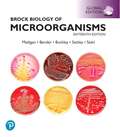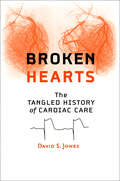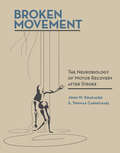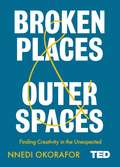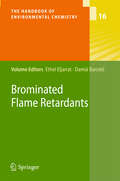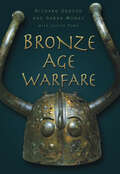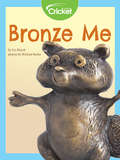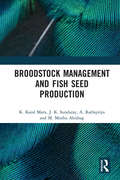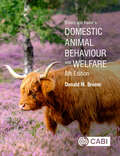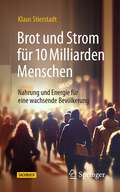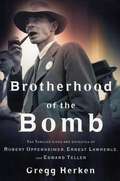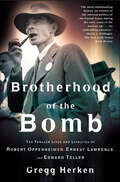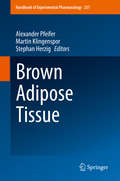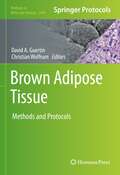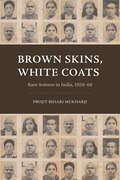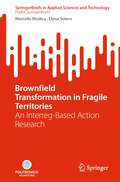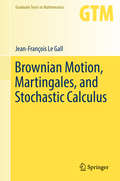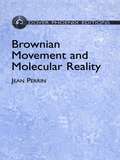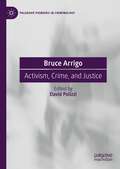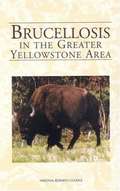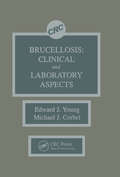- Table View
- List View
Brock Biology of Microorganisms, Global Edition
by Michael Madigan Jennifer Aiyer Daniel Buckley W. Sattley David StahlAuthoritative. Accurate. Accessible. Brock Biology of Microorganisms sets the standard for accuracy, impeccable scholarship, a visually stunning art program, and the use of cutting-edge research to illustrate basic concepts. The text guides students through the six major themes of microbiology ― Evolution, CellStructure and Function, Metabolic Pathways, Information Flow and Genetics,Microbial Systems, and the Impact of Microorganisms ― as outlined by theAmerican Society for Microbiology Conference on Undergraduate Education(ASMCUE). This robust and modern approach takes students through the genomics revolution and “omics” maze that has transformed microbiology and shares powerful tools that microbiologists use to probe deeper and further into the microbial world than ever before. The 16th Edition expands the extraordinary art program to ensure students experience microbiology as a visual science while providing an overview of the microbial world with basic principles that students all need to master. Each chapter’s theme focuses on a recent discovery that connects students with the most current science and engages them with exciting, real-world topics.
Broken Arrow Boy
by Adam MooreWinner of the Gold Award in the 1990 Written and Illustrated By... Contest. At nine years of age, Adam Moore wrote and illustrated BROKEN ARROW BOY, and his book was chosen as a Gold Award Winner in THE 1989 NATIONAL WRITTEN & ILLUSTRATED BY... AWARDS CONTEST FOR STUDENTS. Adam lives in Broken Arrow, Oklahoma, with his parents, Rebecca and Paul, and his two brothers, Ryan, age 13, and Tyler, age 8. When Adam was eight years old, he fell and ran an arrow into his head. The accident led him into a world of hospitals, operations, and physical therapy. These experiences inspired him to create his book which tells of his remarkable recovery. At Indian Springs Elementary School, Adam is a straight "A" fifth-grade student. He has been enrolled in the school's Kaleidoscope gifted program since first grade. At school Adam is an active member of the Computer Club, serves as a Safety Patrol Officer, and has also been a Student Council Representative. He had the honor of having his work selected for publication in his school district's Young Authors' Student Anthology (a short story in 1988-89; and a poem and drawing in 1989-90). In February of 1990, he also had the pleasure of completing Cub Scouts when he attained the Arrow of Light rank. him sur Adam is also an avid collector of stamps, coins and baseball cards. In his spare time, he swims, rides his bicycle, and plays Nintendo and pinball. Adam's weird humor. It was this same wonderful humor that helped him survive and struggled to recuperate from his accident.
Broken Hearts: The Tangled History of Cardiac Care
by David S. JonesA history illustrating the complexity of medical decision making and risk.Still the leading cause of death worldwide, heart disease challenges researchers, clinicians, and patients alike. Each day, thousands of patients and their doctors make decisions about coronary angioplasty and bypass surgery. In Broken Hearts David S. Jones sheds light on the nature and quality of those decisions. He describes the debates over what causes heart attacks and the efforts to understand such unforeseen complications of cardiac surgery as depression, mental fog, and stroke.Why do doctors and patients overestimate the effectiveness and underestimate the dangers of medical interventions, especially when doing so may lead to the overuse of medical therapies? To answer this question, Jones explores the history of cardiology and cardiac surgery in the United States and probes the ambiguities and inconsistencies in medical decision making. Based on extensive reviews of medical literature and archives, this historical perspective on medical decision making and risk highlights personal, professional, and community outcomes.
Broken Movement: The Neurobiology of Motor Recovery after Stroke (The\mit Press Ser.)
by S. Thomas Carmichael John W. KrakauerAn account of the neurobiology of motor recovery in the arm and hand after stroke by two experts in the field.Stroke is a leading cause of disability in adults and recovery is often difficult, with existing rehabilitation therapies largely ineffective. In Broken Movement, John Krakauer and S. Thomas Carmichael, both experts in the field, provide an account of the neurobiology of motor recovery in the arm and hand after stroke. They cover topics that range from behavior to physiology to cellular and molecular biology. Broken Movement is the only accessible single-volume work that covers motor control and motor learning as they apply to stroke recovery and combines them with motor cortical physiology and molecular biology. The authors cast a critical eye at current frameworks and practices, offer new recommendations for promoting recovery, and propose new research directions for the study of brain repair.Krakauer and Carmichael discuss such subjects as the behavioral phenotype of hand and arm paresis in human and non-human primates; the physiology and anatomy of the motor system after stroke; mechanisms of spontaneous recovery; the time course of early recovery; the challenges of chronic stroke; and pharmacological and stem cell therapies. They argue for a new approach in which patients are subjected to higher doses and intensities of rehabilitation in a more dynamic and enriching environment early after stroke. Finally they review the potential of four areas to improve motor recovery: video gaming and virtual reality, invasive brain stimulation, re-opening the sensitive period after stroke, and the application of precision medicine.
Broken Places & Outer Spaces: Finding Creativity In The Unexpected (Ted 2 Ser.)
by Nnedi OkoraforNnedi Okorafor was never supposed to be paralyzed. A college track star and budding entomologist, Nnedi’s lifelong battle with scoliosis was just a bump in her plan - something a simple surgery would easily correct. But when Nnedi wakes from the surgery to find she can’t move her legs, her entire sense of who she is begins to waver. Confined to a hospital bed for months, unusual things begin to happen. Psychedelic bugs crawl her hospital walls; strange dreams visit her nightly. She begins to feel as if she’s turning into a cyborg. Unsure if she’ll ever walk again, Nnedi begins to put these experiences into writing, conjuring up strange, fantastical stories. What Nnedi discovers during her confinement would prove to be the key to her life as a successful science fiction writer: In science fiction, when something breaks, something greater often emerges from the cracks. While she may be bedridden, instead of stopping her journey Nnedi’s paralysis opens up new windows in her mind, kindles her creativity and ultimately leads her to become more alive than she ever could have imagined. Nnedi takes the reader on a journey from her hospital bed deep into her memories, from her painful first experiences with racism as a child in Chicago to her powerful visits to her parents’ hometown in Nigeria, where she got her first inkling that science fiction has roots beyond the West. This was not the Africa that Nnedi knew from Western literature - an Africa that she always read was a place left behind. The role of technology in Nigeria opened her eyes to future-looking Africa: cable TV and cell phones in the village, 419 scammers occupying the cybercafés, the small generator connected to her cousin’s desktop computer, everyone quickly adapting to portable tech devices due to unreliable power sources. Nnedi could see that Africa was far from broken, as she’d been taught, and her experience there planted the early seeds of sci-fi - a genre that speculates about technologies, societies, and social issues - from an entirely new lens. In Broken Places & Outer Spaces, Nnedi uses her own experience as a jumping off point to follow the phenomenon of creativity born from hardship. From Frida Kahlo to Mary Shelly, she examines great artists and writers who have pushed through their limitations, using hardship to fuel their work. Through these compelling stories and her own, Nnedi reveals a universal truth: What we perceive as limitations have the potential to become our greatest strengths - far greater than when we were unbroken.
Brominated Flame Retardants (The Handbook of Environmental Chemistry #16)
by Damià Barceló Ethel EljarratBrominated flame retardants are one of the last classes of halogenated compounds that are still being produced worldwide and used in large quantities in many applications. They are used in plastics, textiles, electronic circuitry, and other materials to prevent fires. This volume covers the state-of-the-art of the analysis, fate and behaviour of brominated flame retardants. Experts in the field provide an overview of the compounds' physico-chemical properties and uses, their occurrence in the environment and biota, advanced chemical analytical methods, degradation studies, toxicological effects and human exposure. This book is a valuable and comprehensive source of information for environmental scientists interested in brominated flame retardant issues, and for authorities and producers.
Bronze Age Warfare
by Richard Osgood Sarah MonksThe Bronze Age, so named because of the technological advances in metalworking and countless innovations in the manufacture and design of tools and weapons, is among the most fascinating periods in human history. Archaeology has taught us much about the way of life, habits and homes of Bronze Age people, but as yet little has been written about warfare. What was Bronze Age warfare like? How did people fight and against whom? What weapons were used? Did they fortify their settlements, and, if so, were these intended as defensive or offensive structures? in response to these and many other questions, Bronze Age Warfare offers and intriguing insight into warfare and society, life and death in Europe 4000 years ago. It describes the surviving evidence of conflict - fortifications, weapons and body protection, burials, human remains and pictorial evidence - and seeks to understand the role played by aggression in the prehistoric world.
Bronze Me
by Liz HuyckHave you ever wondered how bronze statues are made? Bronze is a type of metal, which can be made into different forms when heated at high temperatures. Bronze can be poured into a mold to create a statue. It takes years to master the art of making bronze statues; it includes a five-step process. Learn more about making bronze statues!
Broodstock Management and Fish Seed Production
by K. Karal Marx J. K. Sundaray A. Rathipriya M. Muthu AbishagThe book entitled “Broodstock Management and Fish Seed Production” provides information relating to commercially cultivable fresh water fishes, broodstock management, fish seed production technology, fish seed quality management including induced breeding with neat illustration. Increasing the aquaculture production can be achieved through the supply of quality fish seed. This book will be immensely helpful to farmers, hatchery managers, entrepreneurs and fisheries graduates pursuing research in the area of freshwater broodstock management and sustainable development of freshwater aquaculture in the country. Note: T& F does not sell or distribute the Hardback in India, Pakistan, Nepal, Bhutan, Bangladesh and Sri Lanka.
Broom and Fraser's Domestic Animal Behaviour and Welfare
by Donald BroomCompletely updated and revised, and synthesizing the recent explosion in animal welfare literature, the sixth edition of this best-selling textbook continues to provide a thorough overview of behaviour and welfare of companion and farm animals, including fish. The introductory section has been completely revised, with all following chapters updated, redesigned and improved to reflect our changing understanding. This edition includes: - New and revised chapters on climate change and sustainability, ethics, and philosophy to ensure that the book provides the latest information in a changing world; - New information on human interactions with other animal species, big data, modern technologies, brain function, emotions and behaviour; - Solutions and advice for common abnormal behaviours. Written by a world-leading expert and key opinion leader in animal behaviour and welfare, this text provides a highly accessible guide to the subject. It is an essential foundation for any veterinary, animal science, animal behaviour or welfare-focused undergraduate or graduate course.
Brot und Strom für 10 Milliarden Menschen: Nahrung und Energie für eine wachsende Bevölkerung
by Klaus StierstadtWie lange liefert die Sonne genug Energie für unsere wachsende Bevölkerung?Reichen unsere Dächer aus, um ausreichend Solarstrom zu erzeugen?Stellen Pflanzen und Algen genug Nahrung und Sauerstoff für alle Lebewesen bereit?Millionen Menschen hungern. Strom ist für Milliarden Menschen ein Traum oder zumindest ein Luxusgut. Diese Buch diskutiert mit Hilfe verständlich dargestellter Physik wie weit es zu wenig Ressourcen gibt und wie weit es schlicht eine Problem der Verteilung ist.Das Buch ist gleichermaßen geeignet für Interessierte wie für Personen mit physikalischer Ausbildung. Zahlreiche Vergleiche und Erklärungen zeichnen ein anschauliches Bild, welches durch zahlreiche Abschätzungen und physikalische Details ergänzt wird.
Brotherhood of the Bomb: The Tangled Lives and Loyalties of Robert Oppenheimer, Ernest Lawrence and Edward Teller
by Gregg HerkenThe lives and interactions of Lawrence, Oppenheimer and Teller, who invented the atomic bomb.
Brotherhood of the Bomb: The Tangled Lives and Loyalties of Robert Oppenheimer, Ernest Lawrence, and Edward Teller
by Gregg Herken“The scientists who made the nuclear bomb are the focus of this detailed, engrossing history of one of the greatest scientific discoveries of the 20th century.” —Publishers WeeklyThe story of the twentieth century is largely the story of the power of science and technology. Within that story is the incredible tale of the human conflict between Robert Oppenheimer, Ernest Lawrence, and Edward Teller—the scientists most responsible for the advent of weapons of mass destruction.The story of these three men, builders of the atomic and hydrogen bombs, is fundamentally about loyalty—to country, to science, and to each other—and about the wrenching choices that had to be made when these allegiances came into conflict. In Brotherhood of the Bomb, Gregg Herken gives us the behind-the-scenes account based upon a decade of research, interviews, and newly released Freedom of Information Act and Russian documents.
Brown Adipose Tissue (Handbook of Experimental Pharmacology #251)
by Stephan Herzig Alexander Pfeifer Martin KlingensporThe main focus of this book is on brown adipose tissue and its metabolic function. The book provides a timely update on the latest research and shows where the field is heading. Brown adipose tissue (BAT) dissipates energy and has received considerable attention in the last few years, having been re-discovered in adult humans in 2007/9. Moreover, BAT might offer a target for novel therapies to address obesity, a health condition that has reached pandemic dimensions.
Brown Adipose Tissue: Methods and Protocols (Methods in Molecular Biology #2448)
by David A. Guertin Christian WolfrumThis detailed volume explores techniques for researching brown adipose tissue (BAT) and the fascinating biology and therapeutic potential of thermogenic adipocytes. The content reflects the advancing technologies in genetics, imaging, and 'omics strategies that are allowing researchers to probe BAT biology at unprecedented depths and detail, yet it also presents classic physiology principles, which remain the core tenets of BAT biology. Written for the highly successful Methods in Molecular Biology series, chapters include introductions to their respective topics, lists of the necessary materials and reagents, step-by-step, readily reproducible laboratory protocols, and tips on troubleshooting and avoiding known pitfalls. Authoritative and practical, Brown Adipose Tissue: Methods and Protocols provides perspectives and detailed protocols for the benefit of both new BAT researchers looking for guidance as well as seasoned researchers who would like to expand their toolkits. Chapter 12 is available open access under a Creative Commons Attribution 4.0 International License via link.springer.com.
Brown Skins, White Coats: Race Science in India, 1920–66
by Projit Bihari MukharjiA unique narrative structure brings the history of race science in mid-twentieth-century India to vivid life. There has been a recent explosion in studies of race science in the twentieth and twenty-first centuries, but most have focused either on Europe or on North America and Australia. In this stirring history, Projit Bihari Mukharji illustrates how India appropriated and repurposed race science to its own ends and argues that these appropriations need to be understood within the national and regional contexts of postcolonial nation-making—not merely as footnotes to a Western history of “normal science.” The book comprises seven factual chapters operating at distinct levels—conceptual, practical, and cosmological—and eight fictive interchapters, a series of epistolary exchanges between the Bengali author Hemendrakumar Ray (1888–1963) and the protagonist of his dystopian science fiction novel about race, race science, racial improvement, and dehumanization. In this way, Mukharji fills out the historical moment in which the factual narrative unfolded, vividly revealing its moral, affective, political, and intellectual fissures.
Brown Skins, White Coats: Race Science in India, 1920–66
by Projit Bihari MukharjiA unique narrative structure brings the history of race science in mid-twentieth-century India to vivid life. There has been a recent explosion in studies of race science in the twentieth and twenty-first centuries, but most have focused either on Europe or on North America and Australia. In this stirring history, Projit Bihari Mukharji illustrates how India appropriated and repurposed race science to its own ends and argues that these appropriations need to be understood within the national and regional contexts of postcolonial nation-making—not merely as footnotes to a Western history of “normal science.” The book comprises seven factual chapters operating at distinct levels—conceptual, practical, and cosmological—and eight fictive interchapters, a series of epistolary exchanges between the Bengali author Hemendrakumar Ray (1888–1963) and the protagonist of his dystopian science fiction novel about race, race science, racial improvement, and dehumanization. In this way, Mukharji fills out the historical moment in which the factual narrative unfolded, vividly revealing its moral, affective, political, and intellectual fissures.
Brown Skins, White Coats: Race Science in India, 1920–66
by Projit Bihari MukharjiA unique narrative structure brings the history of race science in mid-twentieth-century India to vivid life. There has been a recent explosion in studies of race science in the twentieth and twenty-first centuries, but most have focused either on Europe or on North America and Australia. In this stirring history, Projit Bihari Mukharji illustrates how India appropriated and repurposed race science to its own ends and argues that these appropriations need to be understood within the national and regional contexts of postcolonial nation-making—not merely as footnotes to a Western history of “normal science.” The book comprises seven factual chapters operating at distinct levels—conceptual, practical, and cosmological—and eight fictive interchapters, a series of epistolary exchanges between the Bengali author Hemendrakumar Ray (1888–1963) and the protagonist of his dystopian science fiction novel about race, race science, racial improvement, and dehumanization. In this way, Mukharji fills out the historical moment in which the factual narrative unfolded, vividly revealing its moral, affective, political, and intellectual fissures.
Brownfield Transformation in Fragile Territories: An Interreg-Based Action Research (SpringerBriefs in Applied Sciences and Technology)
by Marcello Modica Elena SoleroThis book presents and critically evaluates the results of a European territorial cooperation project addressing the planning challenge of brownfield transformation in fragile territories. Set against the backdrop of the current scenario of deindustrialisation in the European Alps, the book describes how to read and interpret the spatial condition of industrial brownfields in peripheral mountain areas as complex transformation sites. Through key theoretical references, well-documented experiences and field activities, the book explores and advances an innovative methodology of design-based participatory planning conceived specifically for fragile socioeconomic and environmental contexts. The empirical basis for such a methodological exploration is provided by four pilot sites distributed between Austria, Italy, France and Slovenia, identified in the cooperation project as highly representative and recurring situations. The book includes a comparative review of the work carried out for the pilot sites, as well as the planning outcomes generated, providing a clear and operative reference for scholars, professionals and public officers called to face similar experiences.
Brownian Motion
by Peter Mörters Yuval PeresThis eagerly awaited textbook covers everything the graduate student in probability wants to know about Brownian motion, as well as the latest research in the area. Starting with the construction of Brownian motion, the book then proceeds to sample path properties like continuity and nowhere differentiability. Notions of fractal dimension are introduced early and are used throughout the book to describe fine properties of Brownian paths. The relation of Brownian motion and random walk is explored from several viewpoints, including a development of the theory of Brownian local times from random walk embeddings. Stochastic integration is introduced as a tool and an accessible treatment of the potential theory of Brownian motion clears the path for an extensive treatment of intersections of Brownian paths. An investigation of exceptional points on the Brownian path and an appendix on SLE processes, by Oded Schramm and Wendelin Werner, lead directly to recent research themes.
Brownian Motion, Martingales, and Stochastic Calculus (Graduate Texts in Mathematics #274)
by Jean-François Le GallThis book offers a rigorous and self-contained presentation of stochastic integration and stochastic calculus within the general framework of continuous semimartingales. The main tools of stochastic calculus, including Itô's formula, the optional stopping theorem and Girsanov's theorem, are treated in detail alongside many illustrative examples. The book also contains an introduction to Markov processes, with applications to solutions of stochastic differential equations and to connections between Brownian motion and partial differential equations. The theory of local times of semimartingales is discussed in the last chapter. Since its invention by Itô, stochastic calculus has proven to be one of the most important techniques of modern probability theory, and has been used in the most recent theoretical advances as well as in applications to other fields such as mathematical finance. Brownian Motion, Martingales, and Stochastic Calculus provides a strong theoretical background to the reader interested in such developments. Beginning graduate or advanced undergraduate students will benefit from this detailed approach to an essential area of probability theory. The emphasis is on concise and efficient presentation, without any concession to mathematical rigor. The material has been taught by the author for several years in graduate courses at two of the most prestigious French universities. The fact that proofs are given with full details makes the book particularly suitable for self-study. The numerous exercises help the reader to get acquainted with the tools of stochastic calculus.
Brownian Movement and Molecular Reality (Dover Books on Physics)
by F. Soddy Jean PerrinHow do we know that molecules really exist? An important clue came from Brownian movement, a concept developed in 1827 by botanist Robert Brown, who noticed that tiny objects like pollen grains shook and moved erratically when viewed under a microscope. Nearly 80 years later, in 1905, Albert Einstein explained this "Brownian motion" as the result of bombardment by molecules. Einstein offered a quantitative explanation by mathematically estimating the average distance covered by the particles over time as a result of molecular bombardment. Four years later, Jean Baptiste Perrin wrote Brownian Movement and Molecular Reality, a work that explains his painstaking measurements of the displacements of particles of a resin suspended in water -- experiments that yielded average displacements in excellent accord with Einstein's theoretical prediction.The studies of Einstein and Perrin provided some of the first concrete evidence for the existence of molecules. Perrin, whose name is familiar to all who employ his methods for calculations in molecular dynamics, received the 1926 Nobel Prize in physics. In this classic paper, he introduced the concept of Avogadro's number, along with other groundbreaking work. Originally published in the French journal Annates de chimie et de physique, it was translated into English by Frederick Soddy to enduring influence and acclaim.
Bruce Arrigo: Activism, Crime, and Justice (Palgrave Pioneers in Criminology)
by David PolizziThis book examines various aspects of the work of Bruce Arrigo related to therapeutic jurisprudence, criminal justice ethics, and the place of critical theory in criminology and related fields. Arrigo’s work spans over thirty years and during that time has been an important voice in the practical and theoretical application of post-modern and critical theoretical approaches to mental illness, the practice of forensic psychology, and a wide variety of critical reflection concerning incarceration, rehabilitation, and the ethical practice within the criminal justice system. Each individual contributor offers their own perspective on his work and its specific influence on the topic under discussion. This book speaks to academics focused on the application of critical criminological theory within a variety of disciplinary contexts. These include forensic psychology, psychological jurisprudence, criminal justice ethics, and philosophically based critiques of the law and mental health and criminal justice activism.
Brucellosis in the Greater Yellowstone Area
by Board On AgricultureBrucellosis, a bacterial disease, was first noted in the Greater Yellowstone Area in 1917 and has been a chronic presence there since then. This book reviews existing scientific knowledge regarding brucellosis transmission among wildlife, particularly bison, elk, and cattle, in the Greater Yellowstone Area. It examines the mechanisms of transmission, risk of infection, and vaccination strategies. The book also assesses the actual infection rate among bison and elk and describes what is known about the prevalence of Brucella abortus among other wildlife.
Brucellosis: Clinical and Laboratory Aspects
by Edward J. Young Michael J. CorbelFourteen brucellosis experts from seven countries discuss the history, epidemiology, microbiology, immunology, diagnosis, treatment, and control of brucellosis in animals and man. Edited by members of the World Health Organization's Expert Committee on Brucellosis, this text is the first comprehensive treatment of the disease since The Nature of Brucellosis by Wesley W. Spink in 1956. Topics reviewed with current references include infection caused by newer species of Brucella, such as B. canis, newer diagnostic techniques, such as radioimmunoassay and ELISA, and newer treatments, such as rifampin and the quinolones. The pathogenesis and pathophysiology of brucellosis is reviewed in depth, correlating the disease in animals with the illness in humans. This volume is extremely useful for clinicians, researchers, and students in medicine, veterinary science, microbiology, immunology, epidemiology, public health, and international health.
